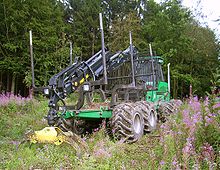Wooden back
The transport of felled trees within the forest to a path from which the trunks, for example , can be found as a wooden back (in Austria : wood delivery ) or simply back . B. be transported away by log car.
Machine workflow
The machine-assisted timber back is done either with forest tractors , winches equipped with forest ropes , with logging trailers, with forwarders , with elliators or with fixed or mobile rope cranes , in very difficult terrain also with helicopters ( heli-logging ).
Forwarder vehicles are more specialized than forest tractors. Both can be equipped with winches. The rope of a rope crane is suspended at two points and can also lift the logs.
A logging trailer is closely related to a forwarder, but mostly designed as a trailer. The equipment of a logging trailer can be very different. Even the simplest trailers with appropriate brackets are sometimes referred to as logging trailers, right up to those with many technical equipment such as loading cranes or drive support on the trailer axles.
Depending on the method, mechanical wood backing in particular can cause severe damage to the forest floor through soil compaction . In order to limit this damage to the smallest possible area, skidding lanes are created that heavy skidding machines must never leave.
Manual workflow
Without the use of forest machines, the work can be done by hand with the Sapie (Sappl), over a wooden giant , with back horses or, as is common in Asia, with elephants .
Wooden giants are channels that were also made of wood in the past to allow the logs (felled trunks) to slide down. They could be built on the ground or raised up to a few meters to give the track an even slope, be up to 300 meters long and be used for 1000 solid cubic meters of wood. At the end of the transport, the giant's building material was also lowered, piece by piece from top to bottom.
Backing wood with back horses has a special tradition in mountain areas, where some of the felled logs are still transported in this way today. The sapie is still used today for maneuvering. Otherwise the occupation of logging has lost a lot of its importance in modern forestry due to the use of machines , but is being revived in near-natural forestry, since the backhorse causes less damage to the tree population and the soil is less compacted.
Onward transport
From the destination of the Holzrücken, a forest road suitable for trucks, for example, the onward transport takes place by log truck or, earlier, by horse and cart, by Trift over a watercourse, with the forest railway or a sledge .
swell
- ↑ Heli-Logging: harvesting wood by helicopter
-
↑ Brin narrowing, Riesbau virtual from DI tie Krieglsteins Holzknechtmuseum, 2010 and
lives of lumberjacks from: Frederick Koerner and Joseph Wenzig, Illustrirte geographic images from Austria , 1856, p 23 - ↑ Logging with a Noriker horse in Schwarzenberg Bregenzerwald. YouTube , September 26, 2014, accessed May 28, 2017.
- ↑ www.waldwissen.net ( Memento of the original from October 20, 2017 in the Internet Archive ) Info: The archive link was inserted automatically and has not yet been checked. Please check the original and archive link according to the instructions and then remove this notice. Comparison of the back horse and the rope tractor

